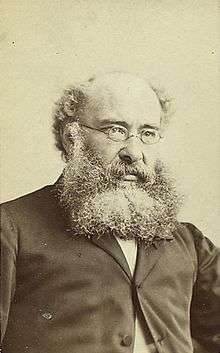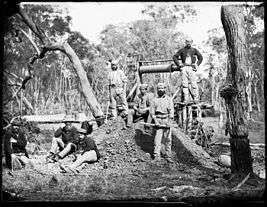Gulgong
Gulgong is a 19th-century gold rush town in the Central Tablelands and the wider Central West regions of the Australian state of New South Wales. The town is situated within the Mid-Western Regional Council local government area. It is located about 300 km (190 mi) north west of Sydney, and about 30 km north of Mudgee along the Castlereagh Highway. At the 2016 Census, Gulgong had a population of 2,521.[1]
| Gulgong New South Wales | |||||||||
|---|---|---|---|---|---|---|---|---|---|
 Main Street | |||||||||
 Gulgong | |||||||||
| Coordinates | 32°21′0″S 149°32′0″E | ||||||||
| Population | 2,521 (2016 census)[1] | ||||||||
| Postcode(s) | 2852 | ||||||||
| Elevation | 475 m (1,558 ft) | ||||||||
| Location | |||||||||
| LGA(s) | Mid-Western Regional Council | ||||||||
| County | Phillip | ||||||||
| State electorate(s) | Dubbo | ||||||||
| Federal Division(s) | Parkes | ||||||||
| |||||||||


Today, much of the 19th century character of the town remains, contributing to its appeal as a tourist destination. Of special interest is the Prince of Wales Opera House, a survivor with a rich history.[2]
An attraction of note is the Gulgong Pioneer Museum, which has a huge collection of thematically-displayed exhibits, ranging from kitchen utensils to complete buildings that have been relocated to a 'street' on the site. Apart from tourism and hospitality, local industries include wine production, wool, wheat growing and coal mining.
Yarrobil National Park is located 21 kilometres (13 mi) north west of Gulgong.
History
The name 'Gulgong' is derived from the word used by the traditional inhabitants, the Wiradjuri, for 'deep waterhole'.
Lieutenant William Lawson passed through the area in November 1820 and again in 1821 and reported good grazing land in the region.[3] This prompted the brothers George and Henry Cox, sons of William Cox, to take up land to the south of the Gudgegong River, while Lawson applied for land grants to the north. Others soon followed, taking up land with river frontage along the Gudgegong. Among the first to take formal possession was Richard Rouse who was granted land in 1825 by Governor Brisbane.[4]
Gulgong came into existence after gold was discovered at Red Hill in 1870. The township was surveyed in August 1870. By the end of that year there were 800 people on the diggings, which yielded over 32 tons of gold in the 1870s.[5] The population had increased to 12,000 by the time the British author Anthony Trollope visited in October 1871.
Gullgong [sic] was certainly a rough place when I visited it, but not quite as rough as I had expected. There was a hotel there, at which I got a bedroom to myself, though but a small one, and made only of slabs. But a gorgeously grand edifice was being built over our heads at the time. The inhabited part of the town consisted of two streets at right angles to each other, in each of which every habitation and shop had probably required but a few days for its erection. The fronts of the shops were covered with large advertisements, the names and praises of traders as is customery now with all new-fangled marts, but the place looked more like a fair than a town ... Everything needful, however, seemed to be at hand. There were bakers, butchers, grocers, and dealers in soft goods. There were public houses and banks in abundance. There was an auctioneer’s establishment, at which I attended the sale of horses and carts. There was a photographer, and there was a theatre, at which I saw the “Colleen Bawn” acted with a great deal of spirit, and a considerable amount of histrionic talent. After the theatre a munificent banker of the town gave us an oyster supper, at a supper-room. It may be inferred, therefore, that the comforts of life have not been altogether neglected at Gullgong. In the middle of the day there had been a public dinner or lunch, at which there was much speaking. I cannot say that the Gullgong oratory was as good as the Gullgong acting or the Gullgong oysters.[6]
The population of the town reached 20,000 in 1873.[5] The Gulgong gold field was one of the last to be developed as 'poor man's diggings', that is by individuals without substantial capital investment.
Novelist and bush poet Henry Lawson lived briefly in Gulgong as a child in the early 1870s, while his father sought instant wealth as a miner. A montage of goldrush-era Gulgong street scenes was used as a backdrop to the portrait of Lawson on the first Australian ten dollar note (which was in use from 1966 until replaced by a polymer banknote in November 1993).[7] The town and its surrounding district feature in Lawson's fiction, especially in Joe Wilson and His Mates.
Gulgong is believed to be one of the primary locations in Thomas Alexander Browne's Robbery under Arms. Australia's first novelist of note, Browne was police magistrate in the period 1871-81. He once hosted English author Anthony Trollope, who later recorded his impressions of Australia and New Zealand (1875).[8]
Heritage listings
Gulgong has a number of heritage-listed sites, including:
- Herbert Street: Hobsons Shops[9]
- 123-125 Mayne Street: The Greatest Wonder of the World and American Tobacco Warehouse and Fancy Goods Emporium[10]
- Wallerawang-Gwabegar railway: Wyaldra Creek railway bridge[11]
- Wallerawang-Gwabegar railway: Gulgong railway station[12]
Railways
Gulgong is at the junction of the Sandy Hollow line (which runs west from Muswellbrook), and the Gwabegar line, (which runs north-south from Gwabegar to Wallerawang). A section of the Gwabegar railway line south of Gulgong to Kandos has been closed since 30 June 2007.
Festival
Gulgong has hosted an international ceramics festival every three years since 1989, most recently over 17 to 23 April 2016.[13]
Notable people
- Jimmy Governor, on whom Thomas Kenneally based his character for The Chant of Jimmy Blacksmith, grew up in the Gulgong district and married there in 1898.
- Nancy Hill (born 1934), Australian basketball representative
- Josh Jackson, rugby league player
- Louisa Lawson, poet and mother of Henry Lawson
- Colin McKellar, Australian senator
Gallery
- Some images of Gulgong NSW

The streets of Gulgong have changed very little since the 19th century 
View from balcony above mechanics workshop 
Mayne St Gulgong 
Typical old commercial buildings in Gulgong 
Prince of Wales Opera House 
Original Gulgong district smithy's house and workshop relocated to 'street' in Gulgong museum 
Local inn, from the 1840s, relocated to museum 'street' 
Interior of the inn 
Horse drawn and motor vehicles in Gulgong museum
References
- "2016 Census QuickStats: Gulgong". www.censusdata.abs.gov.au. Archived from the original on 12 June 2018. Retrieved 27 June 2017.
- Prince of Wales Opera House, Gulgong Archived 22 November 2007 at the Wayback Machine
- Phillip Cox & Wesley Stacey (1973), Historic Towns of Australia, Melbourne, Lansdowne, p.82. ISBN 0701801840
- Cox & Stacey, p.82
- Cox & Stacey, p.84
- Anthony Trollope (1874), New South Wales and Queensland, London, Chapman & Hall, p.67
- Museum of Australian Currency Notes: Australia's First Decimal Currency Notes Archived 22 August 2005 at the Wayback Machine
- "Gulgong - New South Wales - Australia - Travel - smh.com.au". www.smh.com.au. Archived from the original on 14 September 2007. Retrieved 20 September 2007.
- "Hobsons Shops Golden West Trading Post". New South Wales State Heritage Register. Office of Environment and Heritage. H00402. Retrieved 18 May 2018.
- "The Greatest Wonder of the World and American Tobacco Warehouse and Fancy Goods Emporium". New South Wales State Heritage Register. Office of Environment and Heritage. H01983. Retrieved 18 May 2018.
- "Gulgong railway bridge over Wialdra Creek". New South Wales State Heritage Register. Office of Environment and Heritage. H01038. Retrieved 18 May 2018.
- "Gulgong Railway Station and yard group". New South Wales State Heritage Register. Office of Environment and Heritage. H01158. Retrieved 18 May 2018.
- Paine, Sam. "Clay festival to be thrown in Gulgong". Mudgee Guardian. Archived from the original on 5 May 2016. Retrieved 23 April 2016.